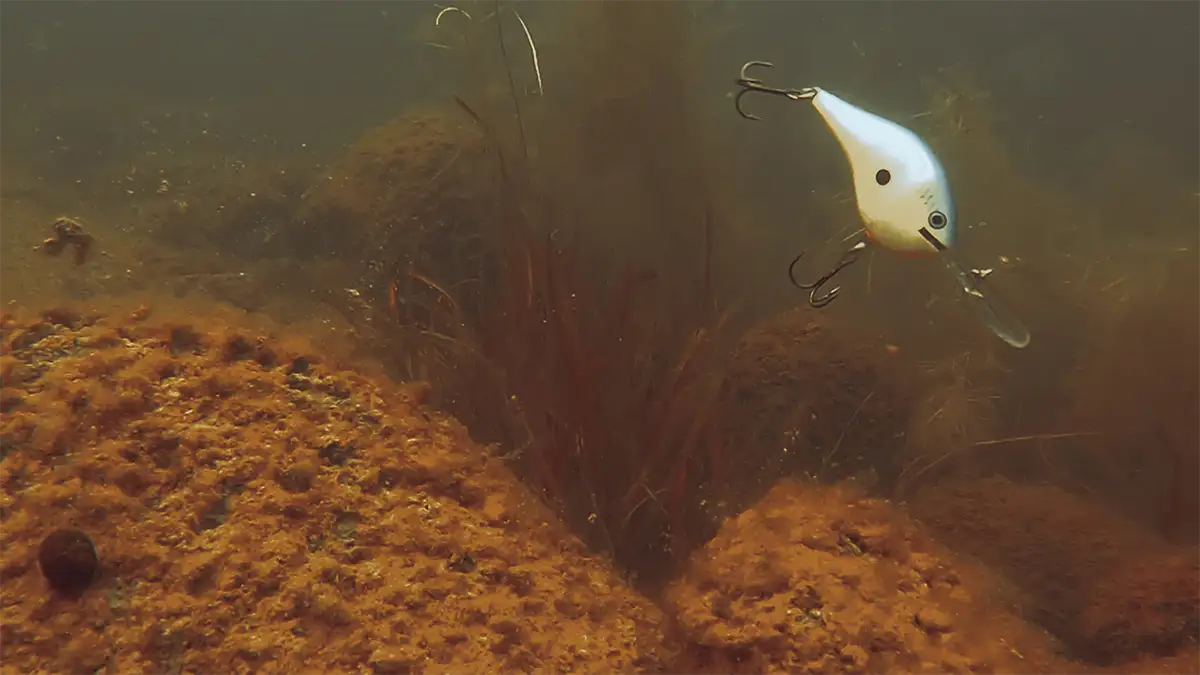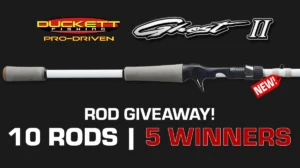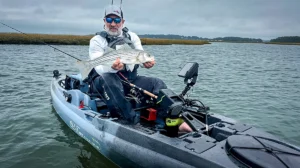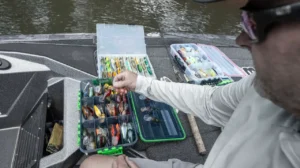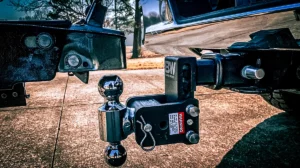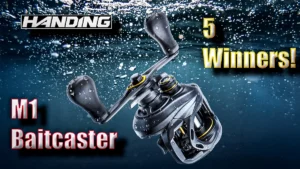Bass fishing with deep-diving crankbaits is a top way to trigger and locate bass relating to deeper structure and cover. Bob Downey shares 6 overlooked tips for increasing success through bait experimentation, upgrading hooks, boat positioning, and using the optimal rod setup. He catches several fish throughout the video, delivering great viewing fun and solid support for each talking point. *Gear links at the bottom.
Downey’s 6 Tips for Deep Diving Crankbait Bass Fishing Success:
- Find good spots. Downey starts by targeting point extensions, humps, and other prominent main lake structures. Use mapping or the naked eye to get you to these spots, and if equipped, put side imaging to work to locate choice areas such as subtle rises, edges, and bottom composition changes such as where rock and gravel meet soft bottom.
- Boat positioning. Position your boat off of these structures. Avoid driving or drifting over the fish to prevent spooking and dispersing the school (think of it like deer hunting). GPS-enabled trolling motors such as Minn Kota’s Spot-Lock allow you to lock the boat in place, freeing you up to thoroughly fan cast spots and experiment with casting angles and different baits.
- Bait experimentation. Mix up baits to determine the best color for the spot and time of day. Downey looks for clues by inspecting how the crankbait is positioned in the mouth of each bass. Changes color if you’re getting short strikes or poorly hooking fish, such as lightly hooked on the tail treble or outside their mouth. You know you have the right color tied on if the bass are consistently pinned with both hooks or hooked inside the mouth. Similarly, having multiple crankbaits rigged with different diving depths allows you to work extra depth ranges without re-rigging downtime. Downey likes the Rapala DT lineup as they take the guesswork out of diving depth if you’re using a conventional 10- or 12-pound fluorocarbon or monofilament line.
- Change hooks. Serious bass anglers are hook snobs — a hook can easily equate to a tournament win and critical points, so it makes sense. While stock hooks are fine for most, there’s no question that premium hooks with characteristics such as heavier wire, different shank lengths, and specialized shapes can improve hooking and landing percentages. And regardless of what hook you use, always pay attention to sharpness, as bottom contact and multiple fish catches dull even the best hooks. Resharpen and replace as necessary to ensure they’re sticky sharp in all situations.
- Use a longer fiberglass rod. Rod selection is highly subjective, but Downey favors using fiberglass over graphite, as he feels the extra “give,” aka shock absorption, reduces boat side bass surging away from the boat. Why go longer? Adding a few inches to your offshore cranking setup increases your casting distance, ease, and fish-fighting efficiency — you’re not target casting, so why not benefit from these attributes?
- Choose a slower reel. Resist the hype of using an ultra-fast gear ratio reel. Deep-diving crankbaits are hard pulling, so a lower geared transmission (reel) is the right tool for the job. Downey opts for a reel in the 6.3:1 gear ratio range as the right compromise of power and cranking speed. Moreover, he feels this gear ratio range works the bait at the designed speeds, allowing them to “hunt” through the bottom and trigger more bites.
TACKLE USED (retail links)
- CRANKBAIT – Rapala Dives-To Series, DT-14
- TREBLE OPTION 1 – VMC Hybrid Treble Hook, sizes 3 and 5
- TREBLE OPTION 2 – VMC Hybrid Treble Short 1x
- ROD – St. Croix Mojo Bass Glass Crankbait Casting Rod, 7’4″ MH
- REEL – Daiwa Tatula Elite Casting Reel, 6.3:1
- LINE – Sufix Advance Fluorocarbon, 10- to 12-pound
FISH FINDER & ELECTRONICS
- FISH FINDER – Humminbird HELIX 10 CHIRP GPS SI+ G4N
- 360 SONAR – Humminbird MEGA 360 Imaging for Minn Kota Ultrex
- TROLLING MOTOR – Minn Kota Ultrex Trolling Motor
- PLIERS – Rapala Elite Pliers
- SUNGLASSES – Costa Del Mar Corbina


